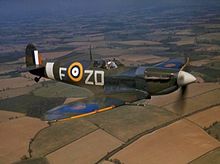No. 222 Squadron RAF
Appearance
| No. 222 (Natal) Squadron RAF | |
|---|---|
| Active | 1 April 1918 - 27 February 1919 5 October 1939 - 1 November 1957 1 May 1960 – 30 June 1964 |
| Country | |
| Branch | |
| Nickname(s) | Natal |
| Motto(s) | Zulu: Pambili bo ("Go straight ahead")[1] |
| Commanders | |
| Notable commanders | |
| Insignia | |
| Squadron Badge heraldry | A Natal, the squadron being the Natal gift squadron; the wildebeest also symbolises speed.[2] |
| Post 1950 squadron roundel |  |
| Squadron Codes | ZD (Oct 1939 - 1953) |
No. 222 Squadron was a Royal Air Force fighter unit.
History
In World War I
The squadron was formally formed at
Officer Commanding 222 Squadron.[3] Later, on 6 April 1918, former "Z" Squadron of No. 2 Wing, RNAS was added to the strength. Renumbered No. 62 Wing and consisting of Nos. 478, 479 and 480 Flights, the squadron was given the task of maintaining raids on Turkish targets in Macedonia and Thrace, operating from islands in the Northern Aegean, officially adopting the 222 Squadron number plate on 14 September 1918.[4] The squadron continued to carry out raids on Turkish targets in the Balkans until the end of the war, eventually disbanding on 27 February 1919.[5]
In World War II

On 5 October 1939 No. 222 Squadron was reformed at
Dieppe raid. In December 1944 the squadron converted to Tempests, which it flew until the squadron was recalled to the UK to re-equip with Meteors.[5]
Entering the jet age
From October 1945 the squadron flew various marks of Meteors for nine years and later, after December 1954 Hunters, being part of Scotland's defence,[7] but on 1 November 1957 No. 222 was disbanded.[4][5]
On Rockets
In its last incarnation on 1 May 1960, No. 222 became a
Bristol Bloodhound SAM unit at RAF Woodhall Spa, but after four years service in this role it disbanded on 30 June 1964.[4][5]
References
Notes
- ISBN 0-7100-9339-X.
- ^ Rawlings 1978, p. 330.
- ^ "Air Chief Marshal Sir Richard Peirse". Air of Authority - A History of RAF Organisation. Archived from the original on 20 November 2012. Retrieved 13 February 2013.
- ^ a b c Jefford 2001, p. 75.
- ^ a b c d e Halley 1988, p. 288.
- ^ Robinson 1999, p. 276.
- ^ Rawlings 1978, p. 331.
Bibliography
- Burton, E. Go straight ahead: Battle of Britain diary of 222 Squadron RAF. London: Square One, 1996.
- Halley, James J. The Squadrons of the Royal Air Force & Commonwealth, 1981-1988. Tonbridge, Kent, UK: Air-Britain (Historians) Ltd., 1988. ISBN 0-85130-164-9.
- Jefford, C.G. RAF Squadrons, a Comprehensive Record of the Movement and Equipment of all RAF Squadrons and their Antecedents since 1912. Shrewsbury, Shropshire, UK: Airlife Publishing, 2001. ISBN 1-84037-141-2.
- Rawlings, John D.R. Coastal, Support and Special Squadrons of the RAF and their Aircraft. London: Jane's Publishing Company Ltd., 1982. ISBN 0-7106-0187-5.
- Rawlings, John D.R. Fighter Squadrons of the RAF and their Aircraft. London: Macdonald and Jane's (Publishers) Ltd., 1978. ISBN 0-354-01028-X.
- Robinson, Anthony. RAF Squadrons in the Battle of Britain. London: Arms and Armour Press Ltd., 1987 (republished 1999 by Brockhampton Press, ISBN 1-86019-907-0.).
External links
Wikimedia Commons has media related to No. 222 Squadron RAF.
